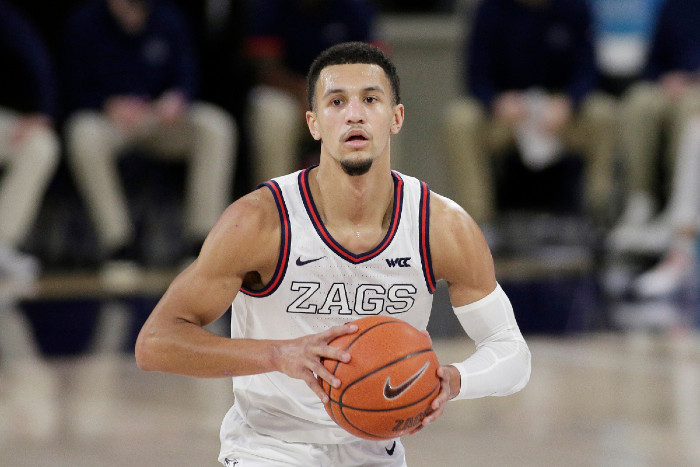“Situational Analysis” is a series of articles that seeks to examine the circumstances that most often influence an NBA prospect’s success. Each player will be scored on a scale from 1-10 in four different categories: NBA-specific skill(s), fatal flaw(s), collegiate/overseas/pre-NBA environment, and ideal NBA ecosystem.
Jalen Suggs is a 20-year-old guard from Saint Paul, Minnesota, who averaged 14.4 points, 5.3 rebounds and 4.5 assists in his freshman season for the Gonzaga Bulldogs. He is expected to be selected among the top-5 picks in the upcoming NBA Draft and as high as No. 2 overall. NBADraft.net currently has him projected at No. 3.
NBA-Specific Skills
Jalen Suggs made one of the greatest shots in the history of college basketball. What else do you need?
OK, sure, some might call it irresponsible to base an entire scouting report on one shot, but sometimes, a split second can tell you everything you need to know about a prospect.
Everyone agrees that Suggs is fearless, savvy, tough, clutch, mature beyond his years – all the superlatives coaches love to throw around. Beyond that, however, Suggs seems to elevate his game when the moment calls for it. He can get to the rim seemingly at will, but his incredible quickness seems to rachet up just a hair toward the end of games. When opponents are getting winded, Suggs is just getting started.
Suggs has all the physical tools and then some, but it’s the speed of his decision-making processes that makes it seem as if he’s playing in a different gear. He plays with supreme confidence and leadership ability.
At 6-4 with excellent length, he can toggle between both guard spots and switch across multiple positions on defense. He rebounds better than most forwards. His potential as a two-way backcourt wrecking ball is unrivaled in this draft.
He’s a bruiser like Jason Kidd or prime Deron Williams with the wheels of De’Aaron Fox or prime John Wall. It’s a rare combination. Suggs is a rare prospect.
On a scale from 1-10, Suggs’ well-rounded game rates at a 9.
Fatal Flaws
Suggs’ outside shooting is most charitably described as “streaky” at this point.
Outside of the occasional 40-foot game-winner, Suggs is not what one would call a reliable perimeter shooter at this point of his development. He hit only 33.7% of his 3s from the college line. When he gets it going (7-10 from 3 versus Iowa, 4-7 versus BYU), he is impossible to defend, but he had more subpar shooting nights than one would like to see from a lottery prospect.
Also, for as savvy and intelligent as Suggs is, he turns the ball over a lot more than one would expect. He can get caught trying to do too much and find himself out of position. The line between “electrifying” and “sloppy” is a thin one.
A lot of these kinks can be worked out through added maturity and experience. But if Suggs can’t develop into at least a league-average 3-point shooter, he might end up having a Marcus Smart-type career – good, but not an All-Star.
On a scale from 1 (not a concern) to 10 (serious hindrance), Suggs’ streaky shooting is an 8.
Pre-NBA Setting
Suggs earned all the accolades one would expect for his exploits on the hardwood, but he also enjoyed an equally impressive high school football career.
It’s not every day you see someone earn the Mr. Basketball and Mr. Football awards in the same season. In fact, it had never happened in the history of Minnesota until Suggs came along.
If Suggs couldn’t hoop, it’s highly likely we would have seen him land on a high-major program as a dual-threat quarterback along the lines of the Vick brothers.
Instead of starring on the gridiron, the Pacific Northwest benefitted from Suggs’ decision to join the Gonzaga Bulldogs and lead them to the cusp of the national title before losing to Baylor.
On a scale from 1-10, Suggs’ pre-NBA career rates at a 9.5. He gets an extra half-point for the shot against UCLA and it would have been a perfect 10 had the Zags beaten Baylor.
Ideal NBA Ecosystem
Suggs is one of the most situationally independent players in this year’s draft. Every team – regardless of roster construction or surrounding talent – needs a fiery 6-4 guard who can do a little bit of everything.
NBADraft.net currently has him slotted at No. 3 to the Cleveland Cavaliers, who already have a young/athletic/erratic backcourt in Darius Garland and Collin Sexton. It would not benefit either party for Suggs to end up here, but it would open up the possibility for the Cavs to trade either half of SexLand for more frontcourt help.
The Houston Rockets are in desperate need of backcourt playmaking, and John Wall (should he remain a Rocket) would be a solid Suggs mentor.
Orlando, picking at No. 5 and 8, have needed a player like Suggs for what seems like decades, but it’s unlikely that he’ll last until Orlando’s first pick. Perhaps a move up would be in order?
Of course, the snuggest landing spot for Suggs is north of the border. If Kyle Lowry elects to move on, that would leave a Suggs-sized hole in the backcourt alongside Fred Van Vleet.
On a scale from 1-10, Suggs’ situational independence rates at a 9. I like Suggs as a dark-horse Rookie of the Year candidate if he ends up on a roster where he gets 25-30 minutes per game.
